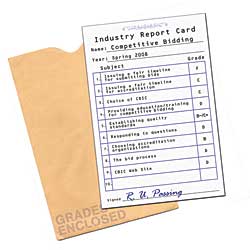Industry Transitions from Theory to Implementation
News on Round 1, Economic Impact and Efforts to Stop Competitive Bidding
- By Elisha Bury
- May 01, 2008
 CMS Notifies Round 1 Bid Winners
CMS Notifies Round 1 Bid Winners
At a March 20 news conference, Centers for Medicare & Medicaid Services (CMS) Acting Administrator Kerry Weems announced that the agency had sent letters via overnight mail to suppliers who submitted bids to participate in the first round of competitive bidding. The letters arrived March 21.
According to Weems, three different types of letters were sent: invitations to sign contracts with CMS if suppliers’ bids were within the winning price ranges, letters explaining to non-winning suppliers that they would not currently be invited to sign a contract, but may be offered a contract in the future if a winning supplier in the same area for some reason dropped out of the program; and letters for disqualified suppliers. Weems said that some suppliers were disqualified from competing for contracts because they fell short of CMS’ “safeguards,” which included failure to meet basic supplier enrollment standards or submitting bids that did not comply with terms and conditions outlined in the requests for bids.
During the bidding period, CMS received “thousands of bids — more than 6,300 — from hundreds of different suppliers,” Weems said, but he declined to answer a question from the HME Media Group as to how many suppliers were offered contracts as “winning bidders.”
Suppliers that were offered contracts had 10 days to respond to CMS to indicate whether or not they wanted to participate.
According to Weems, 64 percent of the bidders offered contracts were small businesses. Under questioning about the program’s potentially negative impact on small businesses, Weems said he was “pleased with the 64-percent figure.”
Weems said overall, Medicare expected to save $1 billion per year once competitive bidding is implemented in the first- and second-round MSAs.
In addition, Weems outlined the ranges of savings Medicare expected on oxygen products. “For oxygen and oxygen equipment, we’re going to see savings of 22 percent in Riverside, California, and 32 percent in Orlando, Florida,” he said. “Medicare currently pays about $199.28 a month for an oxygen concentrator. Under this competitive bidding program, on average across the bidding areas, Medicare will now pay $140.82.”
Weems said that in 2006, Medicare paid about 889,000 monthly payments for oxygen concentrators.
CMS expects to save 29 percent on CPAP equipment, Weems said.
Competitive bidding rates in the first 10 metropolitan statistical areas (MSAs) will be implemented July 1.
For more information on competitive bidding, go to
www.cms.hhs.gov/CompetitiveAcqfor DMEPOS/. Details also were posted at
www.dmecompetitivebid.com/SPA. For more information on mobility products, read the full story at
www.mobilitymgmt.com/articles/60100.
This article originally appeared in the Respiratory Management May 2008 issue of HME Business.
About the Author
Elisha Bury is the editor of Respiratory Management.